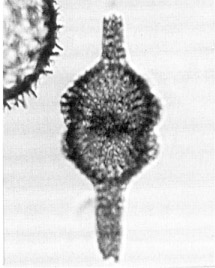 Didymocyrtis
violina (Haeckel)
Didymocyrtis
violina (Haeckel) Didymocyrtis
violina (Haeckel)
Didymocyrtis
violina (Haeckel)Cannartus violina Haeckel, 1887, p.358, pl.39, fig.10; Riedel 1959, p.290, pl.1, fig.3 (with synonymy)
Didymocyrtis violina (Haeckel), Sanfilippo and Riedel, 1980, p.1010
Cortical shell ellipsoidal, with an equatorial constriction and with pores subcircular or circular, twelve to eighteen on the half-equator. On the broader parts of the shell on either side of the equatorial constriction, the shell wall is somewhat thickened and puckered to form short, coarse plicae. At each pole arises a subcylindrical spongy column with meshes much smaller than those of the cortical shell. Medullary shells two, of which the inner is spherical and the outer spherical or lenticularly compressed. The thickened plicae, which are equatorial in [Didymocyrtis tubaria] are situated on the two broad zones of the cortical twin-shell of [Didymocyrtis violina] (Riedel, 1959).
Based on 17 specimens. Length of polar columns 70-130 µm; median breadth 15-33 µm. Length of cortical shell 113-143 µm; maximum breadth 85-108 µm. Breadth of outer medullary shell 33-88 µm (Riedel, 1959).
The equatorial constriction is distinct, and on either side of it the wall of the broader parts of the cortical shell is somewhat thickened and puckered to form short, coarse plicae. The spongy polar columns are narrow (Cannartus violina in Riedel and Sanfilippo, 1978a).
In this species the puckering is confined to the equatorial zone, and in D. mammifera the thickenings of the cortical shell form distinct tubercles rather than plicae (Sanfilippo et al., 1985).
This species is narrowly defined, to include only individuals in which the equatorial constriction is distinct, and on either side of it the wall of the broader parts of the cortical shell is thickened and puckered to form short, coarse plicae. The medullary shell is compressed, lenticular (Sanfilippo et al., 1985).
Didymocyrtis violina is widespread in sediments of middle early to early middle Miocene age in low and middle latitudes of all oceans, including the Mediterranean region. Its morphotypic first appearance lies within the Stichocorys delmontensis Zone and its morphotypic last appearance lies within the Dorcadospyris alata Zone.
D. violina evolved from D. tubaria by poleward migration of the equatorial plicae, becoming more abundant than its ancestor within the Calocycletta costata Zone.
Additional illustrations can be found in Sanfilippo et al., 1973, pl.1, figs.11-12.